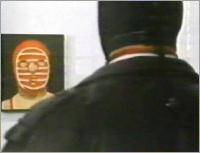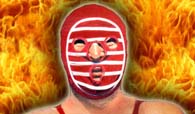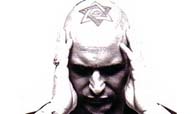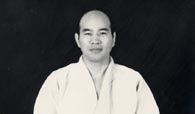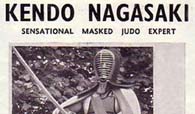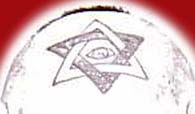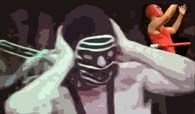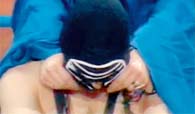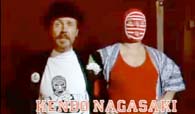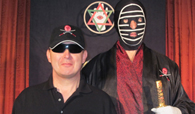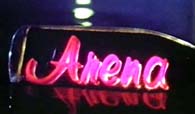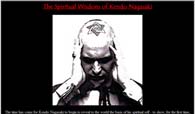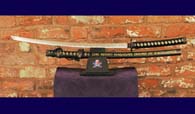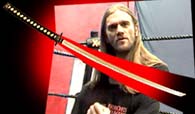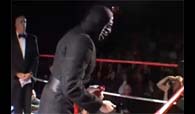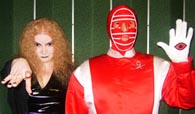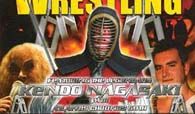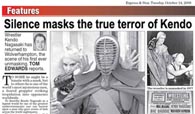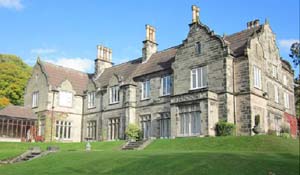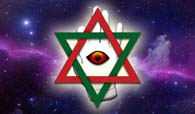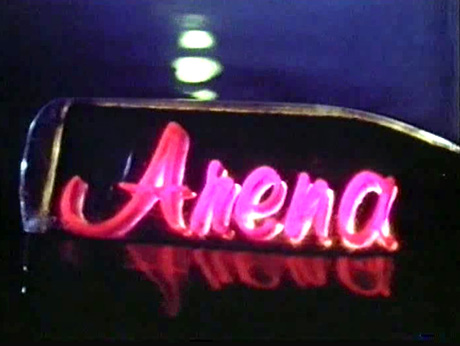
Masters of the Canvas:
the Amazing and Revealing "Arena" Documentary
Generally British wrestlers have never featured largely on television outside of the ITV wrestling slot, but occasionally a wrestler will turn actor and several grapplers have been seen on the small screen in several dramas over the years (including of course Nagasaki’s own appearance in The Wild Bunch). This changed in the spring of 1992 when a most startling programme went to air as part of BBC 2’s famous Arena arts strand.
Television producer and poet Paul Yates had been a huge Nagasaki fan since the 1960’s, following his career development from ringside and via the World Of Sport transmissions, recognising that in Kendo Nagasaki there was a true enigma. In his role as a producer, Yates had the idea of getting the widely respected pop artist Peter Blake (now Sir Peter Blake) to paint Kendo’s portrait. Like Yates, Blake had said in press interviews that his hero was Kendo Nagasaki, and in a Sunday Times article had admitted he wished to experience what it was like being Kendo Nagasaki. So far so good. All Paul Yates had to do was persuade Kendo to sit for the portrait, but there was more: Yates also wanted Kendo to agree to his first television interview ever.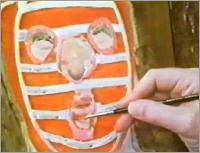 A meeting was set up with Lloyd Ryan who proved to be very unhelpful, and the unfolding drama as Yates attempts to play cat and mouse with Kendo is riveting. Eventually Lloyd Ryan agrees to a portrait sitting, but first some reference photographs were needed, and for this Royal photographer, the late Terence Donovan, was called in. The session is conducted in silence; as usual Kendo arrives at the studio with Lloyd and Mr. Lawrence in tow but speaks to nobody, not even the acclaimed photographer Donovan, all requests are conducted through Ryan. After the session, Donovan recalls seeing a young English judo champion many years before in Japan who defeated the then heavyweight judo champion of the world. What marked out this young man was that he had a finger missing on his left hand - exactly the same finger that Kendo has missing, Donovan surmised that it could well have been the same man but because he cannot see the face then he cannot be sure. Another link in establishing the identity of Kendo Nagasaki is formed and gives Paul Yates yet more food for thought...
A meeting was set up with Lloyd Ryan who proved to be very unhelpful, and the unfolding drama as Yates attempts to play cat and mouse with Kendo is riveting. Eventually Lloyd Ryan agrees to a portrait sitting, but first some reference photographs were needed, and for this Royal photographer, the late Terence Donovan, was called in. The session is conducted in silence; as usual Kendo arrives at the studio with Lloyd and Mr. Lawrence in tow but speaks to nobody, not even the acclaimed photographer Donovan, all requests are conducted through Ryan. After the session, Donovan recalls seeing a young English judo champion many years before in Japan who defeated the then heavyweight judo champion of the world. What marked out this young man was that he had a finger missing on his left hand - exactly the same finger that Kendo has missing, Donovan surmised that it could well have been the same man but because he cannot see the face then he cannot be sure. Another link in establishing the identity of Kendo Nagasaki is formed and gives Paul Yates yet more food for thought...
Eventually, Kendo arrives at Peter Blake’s house for the portrait sitting, these two masters of the canvas sit in silence with the legendary red eyes peering out from the mask as Blake commits the image for all time with oils...
One of the main features of the programme is the title contest at Croydon for the CWA World Heavyweight Championship. In the opposing corner is the giant frame of one of Kendo’s deadliest ring rivals, Haystacks, now weighing an incredible 46 stones. In typical fashion, Kendo and Lloyd refuse to accept Pat Roach as the special referee arguing that as one of Nagasaki’s rivals he was biased. Then lightweight Steve Grey agrees to step in so that the contest can continue, as the two mightiest men in world wrestling get to grips in a contest that thrilled the capacity Croydon audience...
Haystacks got an early upper hand by throwing about his enormous bulk successfully, but Kendo is quick to retaliate and a failed super-splash by Haystacks allows Kendo to kick him out of the ring and to continue the attack at ringside. Tag partner Bob Barratt illegally tackles the giant and Kendo attacks Haystacks with the timekeeper’s bell, with blood flowing from Haystacks forehead Kendo gets back into the ring and continues the blows whilst Haystacks is standing on the ring apron. Grey tries to separate the two gladiators but the wild temper of Nagasaki means that he is on the receiving end of the Kamikaze Crash thus rendering him unconscious. With Roach now in the ring trying to restore order, Haystacks gets in and grabs Nagasaki from behind and rips the mask from his head. The crowd go wild as Kendo heads back to the dressing room. With Kendo counted out Haystacks is awarded the title on a technical knockout, and of course Lloyd Ryan is far from happy at the outcome. It has been a classic struggle and on this occasion Haystacks has won the battle but the war would be far from over as the continuing bitter clashes around the UK would confirm over the following months.
Returning to Yates' pursuit of Kendo, Lloyd Ryan finally contacts him to say that against his personal wishes Kendo has agreed to an interview, the meeting place being a deserted car park in west London. The scene is set for a moment of wrestling history - however things are seldom that simple in dealings with Kendo Nagasaki. As the huge car draws up Yates takes the back seat with the masked legend, only to have Lloyd Ryan take the microphone from his hand. The interview it turns out will be conducted without sound, allowing the viewer to see but not to hear. Luckily the interview is then subtitled at the bottom of the screen, and for the first time in his long and illustrious career Kendo gives a one-to-one television interview.
The Masters of the Canvas Nagasaki Interview:
Kendo Nagasaki: Paul, before we start there are two points that I want to make clear to you. I have read some of your poetry and I’ve also monitored your actions over the last nine months and I’ve come to the conclusion that you are a serious observer of the Kendo Nagasaki phenomenon. Taking that into mind I’ve granted the interview but let me make one point clear to you, if this interview doesn’t go the way I think it should go I will soon bring it to a swift conclusion.
You’ve managed to convince me that you are not a cheap, sensation-seeking reporter trying to make a quick buck. The other point is, and it’s a problem for you and me in fact, is that Kendo Nagasaki is only truly experienced in the wrestling ring and even then only after a period of time and meditation when he manifests himself - or the persona manifests itself - in me. So you see this interview really isn’t taking place with Kendo Nagasaki. Taking that into consideration I am prepared to try and answer the questions on his behalf. So providing you’ve understood all that, we can continue.
Paul Yates: Can I just begin in that case by asking: how did this process which links you and Kendo originate?
Kendo Nagasaki: During periods of deep meditation I felt that I was being, perhaps contacted is the wrong word, but I felt an influence of the Samurai coming into me and this is how Nagasaki really started. His birth came from these early influences.
Paul Yates: Considering the persona emerged via a meditative process, wasn’t the wrestling ring a strange place for him to manifest himself?
Kendo Nagasaki: I don’t think so. Wrestling lends itself to extrovert characters and I think that Nagasaki is an extrovert character. You have the drama of the wrestling ring, the theatre of the wrestling ring, and all these things help to build that character and that persona.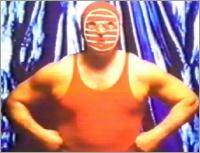 Paul Yates: What can you tell me about the top of the left index finger being missing and the eyes turning red in the ring?
Paul Yates: What can you tell me about the top of the left index finger being missing and the eyes turning red in the ring?
Kendo Nagasaki: There are certain times and certain rituals in Japanese mythology, and in reality, when people are required to remove the top of a finger. I can tell you that the Samurai that influences Kendo Nagasaki did have the top of his finger removed - the same finger. But whether this finger was lost by accident or by design I refuse to comment on. About the eyes - I think that everybody sees something in Kendo Nagasaki, red eyes... This, that and the other. I don’t make any statements or claims about that.
Paul Yates: Two other aspects of the Kendo Nagasaki phenomenon are his apparent healing and hypnotic powers.
Kendo Nagasaki: It is absolutely true that Nagasaki does have these powers. Both are used in different ways. The hypnosis is used sometimes in the wrestling ring. The healing power is mainly used for good - well, it is always used for good in fact. It’s a need, I think, to have contrast between the violence and the rough and tumble in the wrestling ring and also the need to be able to help people.
Paul Yates: Do you think that Peter Blake’s fantasy about Kendo might be shared by other people?
Kendo Nagasaki: Yes, in a way. I think people are all trying to escape from something, from reality into another world or a fantasy. Nagasaki is the perfect vehicle because there is no face, so you could actually put any face behind that mask and you can give it any features, any character you want. You can put your face behind the mask in your own mind. So he works for everybody.
Paul Yates: Do you feel that the manifestation of Kendo Nagasaki in your life was necessary because you felt something was missing personally?
Kendo Nagasaki: Yes, I think in my early life there was an emptiness and a need for fulfilment. I didn’t have a particularly pleasant childhood so, yes, there was a need for this superman character to come into my life.
Paul Yates: Can we assume that there were moments of solitude and isolation where you perhaps desired that greater strength?
Kendo Nagasaki: Yes you can, you may assume those things, they are perfectly true. They were moments of abandonment really. I felt the need for a superior strength which eventually became Nagasaki.
Paul Yates: Do you ever feel nowadays trapped by the persona of Nagasaki?
Kendo Nagasaki: Well...
Paul Yates: Does he restrict you?
Kendo Nagasaki: No, he doesn’t restrict me. He’s restricted in himself because he can’t move on. He doesn’t restrict me, I am able to throw him off and I have a totally separate life outside Nagasaki.
Paul Yates: You also have another life in business and commerce. How much of a role does the strength of Nagasaki play in a boardroom debate or a board room battle?
Kendo Nagasaki: No, I don’t think it comes into that at all. I don’t conduct any of my business affairs as a battle. I prefer to have total harmony in any business transactions that I have and I manage to achieve that. I think if Nagasaki’s taught me anything he’s taught me to compromise.
Paul Yates: Really? Compromise? Compromise isn’t a word I would associate with Nagasaki?
Kendo Nagasaki: That’s only what he’s taught me. I didn’t say he would compromise. If you don’t compromise you become isolated like Nagasaki. I don’t want to be like that. I don’t want to be personally like that. Although his influence has helped me in other ways, I don’t want to be like that...
The long and arduous journey has been worth it for Paul Yates - for the very first time Nagasaki has talked on television about the mystery that surrounds him in the wrestling ring. When the programme was transmitted reviewers were more than generous with their praise for the documentary, it was generally claimed that this was the finest programme ever broadcast about wrestling. Around the halls of the UK Kendo’s reputation was enhanced with the showing of the programme, and he continued on his destructive streak, destroying everyone in the opposite corner.
The programme ends with Nagasaki himself covertly viewing the Blake portrait, in a private late-night viewing at a London gallery; such an enigmatic character surveying an artistic rendition of himself remains a profoundly haunting image in itself.
